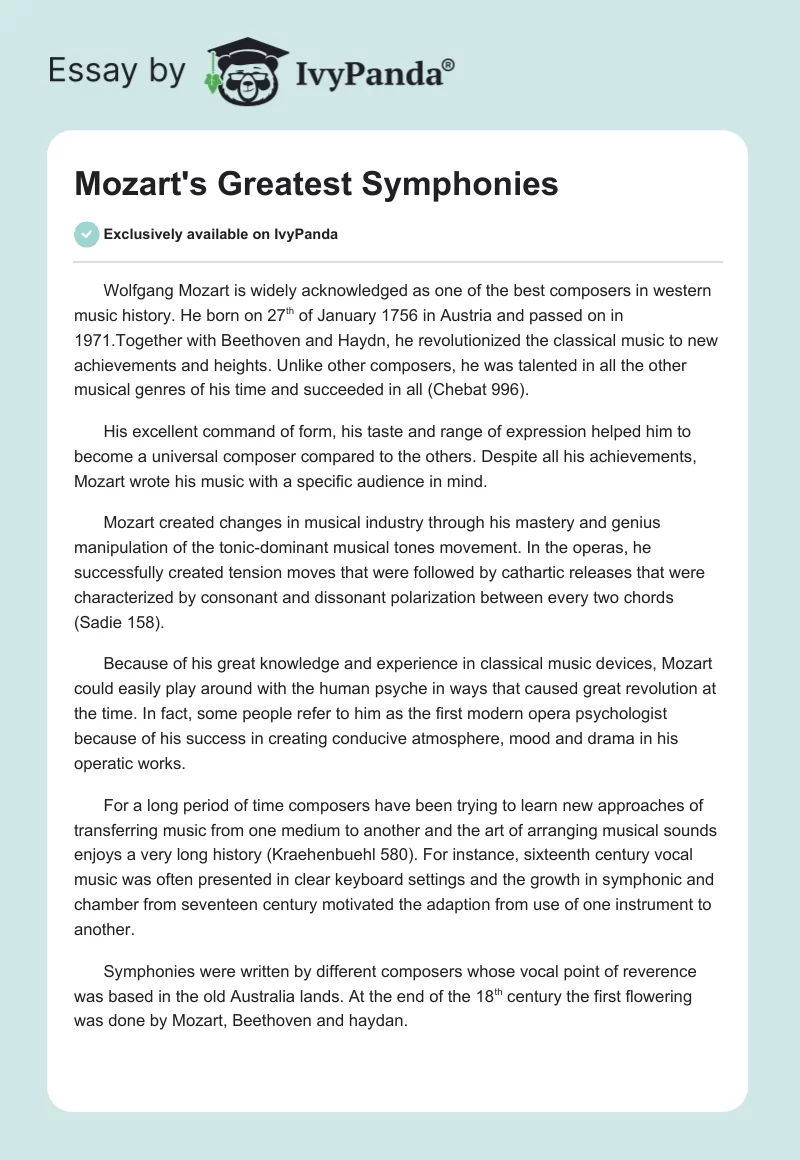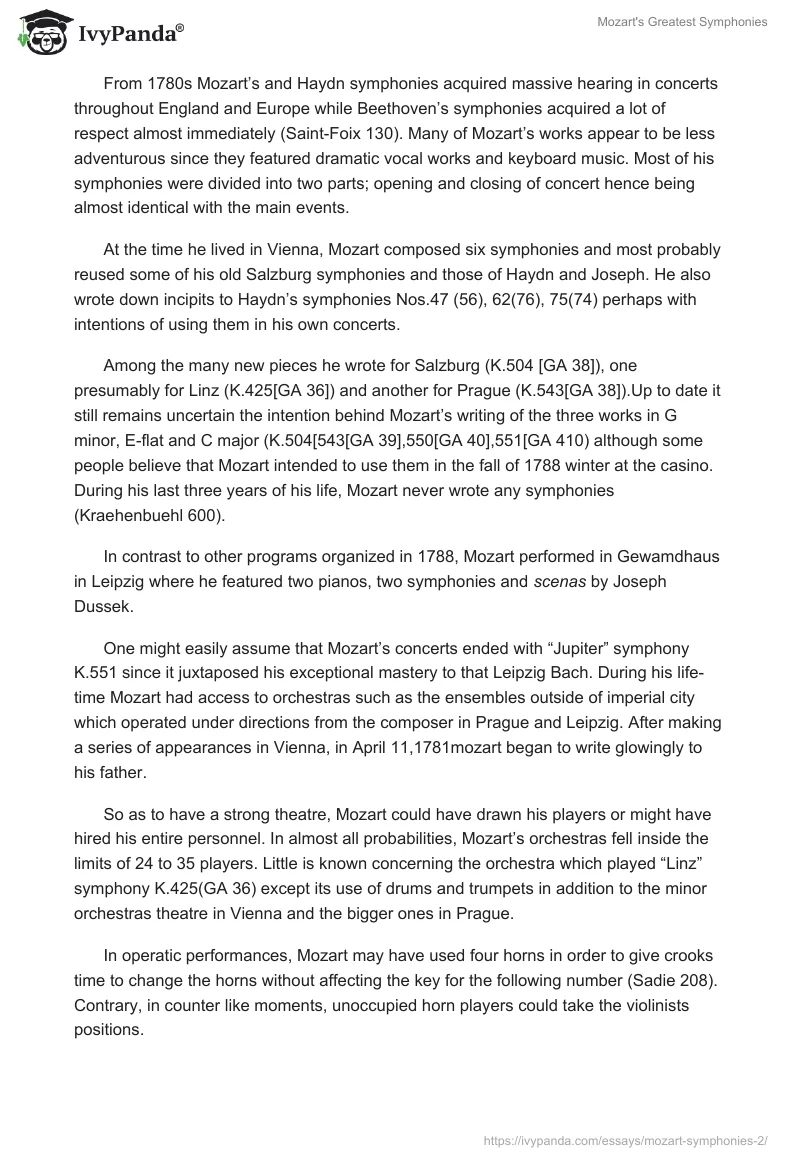Wolfgang Mozart is widely acknowledged as one of the best composers in western music history. He born on 27th of January 1756 in Austria and passed on in 1971.Together with Beethoven and Haydn, he revolutionized the classical music to new achievements and heights. Unlike other composers, he was talented in all the other musical genres of his time and succeeded in all (Chebat 996).
His excellent command of form, his taste and range of expression helped him to become a universal composer compared to the others. Despite all his achievements, Mozart wrote his music with a specific audience in mind.
Mozart created changes in musical industry through his mastery and genius manipulation of the tonic-dominant musical tones movement. In the operas, he successfully created tension moves that were followed by cathartic releases that were characterized by consonant and dissonant polarization between every two chords (Sadie 158).
Because of his great knowledge and experience in classical music devices, Mozart could easily play around with the human psyche in ways that caused great revolution at the time. In fact, some people refer to him as the first modern opera psychologist because of his success in creating conducive atmosphere, mood and drama in his operatic works.
For a long period of time composers have been trying to learn new approaches of transferring music from one medium to another and the art of arranging musical sounds enjoys a very long history (Kraehenbuehl 580). For instance, sixteenth century vocal music was often presented in clear keyboard settings and the growth in symphonic and chamber from seventeen century motivated the adaption from use of one instrument to another.
Symphonies were written by different composers whose vocal point of reverence was based in the old Australia lands. At the end of the 18th century the first flowering was done by Mozart, Beethoven and haydan.
From 1780s Mozart’s and Haydn symphonies acquired massive hearing in concerts throughout England and Europe while Beethoven’s symphonies acquired a lot of respect almost immediately (Saint-Foix 130). Many of Mozart’s works appear to be less adventurous since they featured dramatic vocal works and keyboard music. Most of his symphonies were divided into two parts; opening and closing of concert hence being almost identical with the main events.
At the time he lived in Vienna, Mozart composed six symphonies and most probably reused some of his old Salzburg symphonies and those of Haydn and Joseph. He also wrote down incipits to Haydn’s symphonies Nos.47 (56), 62(76), 75(74) perhaps with intentions of using them in his own concerts.
Among the many new pieces he wrote for Salzburg (K.504 [GA 38]), one presumably for Linz (K.425[GA 36]) and another for Prague (K.543[GA 38]).Up to date it still remains uncertain the intention behind Mozart’s writing of the three works in G minor, E-flat and C major (K.504[543[GA 39],550[GA 40],551[GA 410) although some people believe that Mozart intended to use them in the fall of 1788 winter at the casino. During his last three years of his life, Mozart never wrote any symphonies (Kraehenbuehl 600).
In contrast to other programs organized in 1788, Mozart performed in Gewamdhaus in Leipzig where he featured two pianos, two symphonies and scenas by Joseph Dussek.
One might easily assume that Mozart’s concerts ended with “Jupiter” symphony K.551 since it juxtaposed his exceptional mastery to that Leipzig Bach. During his life-time Mozart had access to orchestras such as the ensembles outside of imperial city which operated under directions from the composer in Prague and Leipzig. After making a series of appearances in Vienna, in April 11,1781mozart began to write glowingly to his father.
So as to have a strong theatre, Mozart could have drawn his players or might have hired his entire personnel. In almost all probabilities, Mozart’s orchestras fell inside the limits of 24 to 35 players. Little is known concerning the orchestra which played “Linz” symphony K.425(GA 36) except its use of drums and trumpets in addition to the minor orchestras theatre in Vienna and the bigger ones in Prague.
In operatic performances, Mozart may have used four horns in order to give crooks time to change the horns without affecting the key for the following number (Sadie 208). Contrary, in counter like moments, unoccupied horn players could take the violinists positions.
In order for an individual to do an effective performance of the eighteen-century symphony with stylishness, it is very important to understand the eighteenth-century orchestra. One has to acknowledge certain assumptions and facts borrowed from sounds produced during Mozart’s day in order to make necessary adjustments to the modern sounds.
This is especially true because orchestras then, just as today, possessed similar traits and characteristics (Saint-Foix 145). Mozart’s symphonies were characterized by a very firm continuo bass-line. A bassoon is supposed to be double the string bass even when the score is not specified, although Mozart used it as a harmony-filler.
It was not easy for collector of gramophone records to gain access to Mozart’s symphonies. Record companies gave greater attention to the later and best-known symphonies compared to those in the era of 78-rpm shellac disc. Surprisingly enough, No. 39 that had 17 recordings received more attention than those with popular nicknames (Zaslaw 78).
Sir Thomas Beecham had showed a lot of interest in recording Mozart’s symphonies way before the arrival of long-playing record. He rerecorded ten in the gramophone. Later on Denis Vaughan became the next conductor to express his interest in tackling substantial portion in the repertoire or gramophone.
He showed great courage by including harpsichord continuo as regular features of the repertoire. His performances clearly brought out the horn’s tones, something that refined Mozart’s music.
Vaughan employed B flat alto horns In No.24 but of more importance was the display on disc for the first time for horns in “E flat alto” in No.19.At the same time, as Vaughan was recording Mozart’s music, the American Vox company embarked on a series with Mainz chamber orchestra and Guther kehr. However, the conductor did not complete all the recordings hence philharmonia Hungarica and kehr Maag supplied the remaining six authentic symphonies.
Although Mozart had a very short career, he was successful in creating tremendous musical output by any expected standards. He managed to create 600 works in which forty-one of them were symphonies (Chebat 998). He acquired his musical genius and talent as a result of being exposed at early age.
Together with his sister and their father, he performed at different courts in Austria. He managed to write to write his symphonies in different genres and was able to communicate to his target audience in an effective manner. His contributions created a great revolution in classical music in terms of form, subject and the mode of delivery.
Works Cited
Chebat, Gelinas-Chebat. “Interactive effects of musical and visual cues on time perception: an application to waiting lines in banks.” Perceptual and Motor Skills 77.3(1993):995-1020.print.
Kraehenbuehl, Coons. “Information as a measure of the experience of music.” The Journal of Aesthetics and Art Criticism 17.4(1959):510-522.print.
Sadie, Sean. Mozart symphonies.New York: Ariel Music.1986, print.
Saint-Foix, Grant. “The symphonies of Mozart.” Translated by Leslie Orrey. London. D. 12.5(1948) 120-150.print.
Zaslaw,Wolfgang Amadeus. Mozart’s symphonies: context, performance practice, reception.Chicago: Clarendon Press.1985,print.


